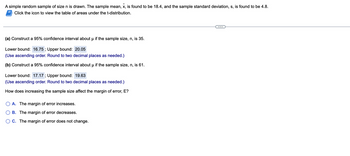(a) Construct a 95% confidence interval about μ if the sample size, n, is 35. Lower bound: 16.75; Upper bound: 20.05 (Use ascending order. Round to two decimal places as needed.) (b) Construct a 95% confidence interval about μ if the sample size, n, is 61. Lower bound:; Upper bound: (Use ascending order. Round to two decimal places as needed.) C•••
(a) Construct a 95% confidence interval about μ if the sample size, n, is 35. Lower bound: 16.75; Upper bound: 20.05 (Use ascending order. Round to two decimal places as needed.) (b) Construct a 95% confidence interval about μ if the sample size, n, is 61. Lower bound:; Upper bound: (Use ascending order. Round to two decimal places as needed.) C•••
MATLAB: An Introduction with Applications
6th Edition
ISBN:9781119256830
Author:Amos Gilat
Publisher:Amos Gilat
Chapter1: Starting With Matlab
Section: Chapter Questions
Problem 1P
Related questions
Question

Transcribed Image Text:A simple random sample of size n is drawn. The sample mean, x, is found to be 18.4, and the sample standard deviation, s, is found to be 4.8.
Click the icon to view the table of areas under the t-distribution.
(a) Construct a 95% confidence interval about µ if the sample size, n, is 35.
μ
Lower bound: 16.75; Upper bound: 20.05
(Use ascending order. Round to two decimal places as needed.)
(b) Construct a 95% confidence interval about µ if the sample size, n, is 61.
μ
Lower bound:; Upper bound:
(Use ascending order. Round to two decimal places as needed.)
Expert Solution
This question has been solved!
Explore an expertly crafted, step-by-step solution for a thorough understanding of key concepts.
This is a popular solution!
Trending now
This is a popular solution!
Step by step
Solved in 3 steps with 1 images

Follow-up Questions
Read through expert solutions to related follow-up questions below.
Follow-up Question

Transcribed Image Text:A simple random sample of size \( n \) is drawn. The sample mean, \( \bar{x} \), is found to be 18.4, and the sample standard deviation, \( s \), is found to be 4.8.
Click the icon to view the table of areas under the t-distribution.
---
**(a)** Construct a 95% confidence interval about \( \mu \) if the sample size, \( n \), is 35.
- Lower bound: \( 16.75 \) ; Upper bound: \( 20.05 \)
(Use ascending order. Round to two decimal places as needed.)
**(b)** Construct a 95% confidence interval about \( \mu \) if the sample size, \( n \), is 61.
- Lower bound: \( 17.17 \) ; Upper bound: \( 19.63 \)
(Use ascending order. Round to two decimal places as needed.)
How does increasing the sample size affect the margin of error, \( E \)?
- \( \bigcirc \) A. The margin of error increases.
- \( \bigcirc \) B. The margin of error decreases.
- \( \bigcirc \) C. The margin of error does not change.
Solution
Recommended textbooks for you

MATLAB: An Introduction with Applications
Statistics
ISBN:
9781119256830
Author:
Amos Gilat
Publisher:
John Wiley & Sons Inc

Probability and Statistics for Engineering and th…
Statistics
ISBN:
9781305251809
Author:
Jay L. Devore
Publisher:
Cengage Learning

Statistics for The Behavioral Sciences (MindTap C…
Statistics
ISBN:
9781305504912
Author:
Frederick J Gravetter, Larry B. Wallnau
Publisher:
Cengage Learning

MATLAB: An Introduction with Applications
Statistics
ISBN:
9781119256830
Author:
Amos Gilat
Publisher:
John Wiley & Sons Inc

Probability and Statistics for Engineering and th…
Statistics
ISBN:
9781305251809
Author:
Jay L. Devore
Publisher:
Cengage Learning

Statistics for The Behavioral Sciences (MindTap C…
Statistics
ISBN:
9781305504912
Author:
Frederick J Gravetter, Larry B. Wallnau
Publisher:
Cengage Learning

Elementary Statistics: Picturing the World (7th E…
Statistics
ISBN:
9780134683416
Author:
Ron Larson, Betsy Farber
Publisher:
PEARSON

The Basic Practice of Statistics
Statistics
ISBN:
9781319042578
Author:
David S. Moore, William I. Notz, Michael A. Fligner
Publisher:
W. H. Freeman

Introduction to the Practice of Statistics
Statistics
ISBN:
9781319013387
Author:
David S. Moore, George P. McCabe, Bruce A. Craig
Publisher:
W. H. Freeman